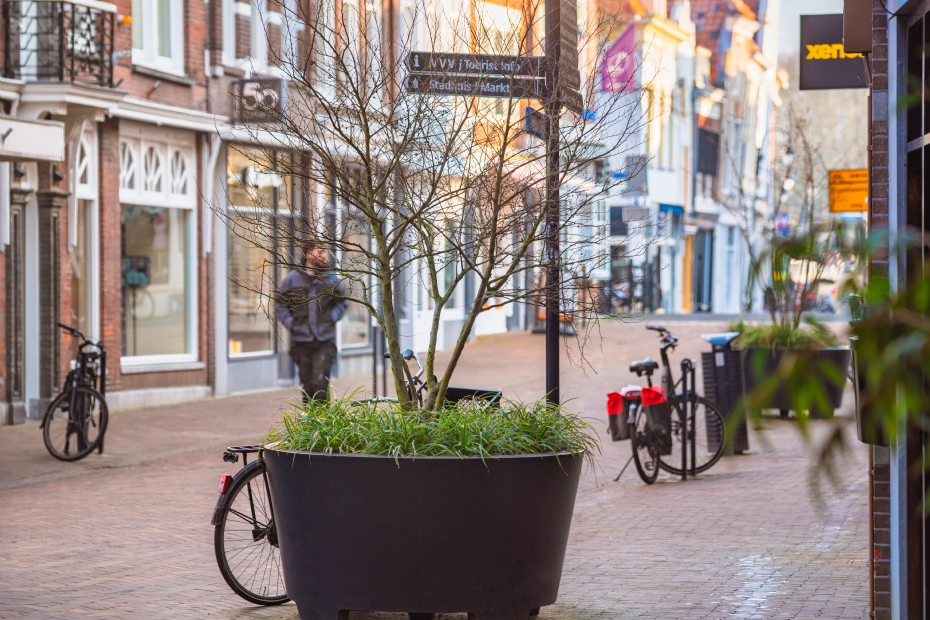FURNS Supplies Mobile Planters for Greening Gouda City Centre |
|
|
|
|
 |
| 138 sec |
Sensors Monitor Moisture Levels
"Ten round planters from FURNS have recently been installed in the city centre of Gouda," says account manager Alexander Meloen, who is responsible for municipal relations at FURNS. "This is part of the Public Space Quality Plan for the city centre. Gouda wants to green the city and opted for mobile planters that can be removed during events. They are waterproof and equipped with overflow pipes, so that excess water—after heavy rainfall, for example—can be drained."
| Planters green the Lange Tiendeweg in the city centre of Gouda. Photography: FURNS. |
"Like Dordrecht, where we also recently placed mobile planters, the city centre of Gouda is highly urbanised," says Meloen. "The municipality wants to make the centre greener and organised evening meetings with local entrepreneurs to discuss it. They opted for planters because there is a dense infrastructure beneath the paving. The planters couldn't be too small (they would be lost in the streetscape), but also not too large, because emergency services require at least 3.5 meters of clearance." The planters stand on feet and are easy to move. "We also offer bottomless planters and prefer to plant directly in the ground, but we understand that isn't always possible due to infrastructure. They also need to be removable during events."
Alignment With Pavement
"Siep van Jaarsveld, project leader for the Public Space Project, explained that the municipality was looking for suitable options. After the selection process, our company came out on top. People from the municipality saw conical planters on our website—a round shape, 1,500 mm in diameter and 800 mm in height. They chose aluminum, powder-coated in a dark blue-black color. In Lange Tiendeweg, new paving stones had just been laid in various colors: red, sand, brown, and dark grey. They wanted something to match that."
The planters taper downward; they are wider at the top than at the base. The round shape also ties in well with the circular plastic cheeses found all over Gouda's streets and canals. "Gouda has so far placed ten planters in the city centre, and two more are still to be installed. The municipality ordered twelve in total."
|
|
"Sensors were installed so the manager knows exactly when water is needed."
| |
|
 | | The planters stand on feet, making them easy to move. |
|
|
Sensors
Project leader Van Jaarsveld says the municipality chose waterproof planters so they retain water longer, making the project more climate-resilient. Sensor company Green-DMS installed moisture sensors in the planters so managers know exactly when water is needed. "They can see it via color indicators in an app. Red means immediate action is required."
"Our planters are not waterproof by default. They are made waterproof by applying a polyurea coating. Once waterproofed, overflow pipes are installed to drain excess water. These pipes are hidden inside the planter and not visible from the outside. The planters also contain metal rings to loop a tension strap through—similar to securing a strap on a car roof. One ring is placed in each corner. Since the planters are raised on feet, they are also easy to move."
Trees
"The planting was chosen by the municipality; that's not our area of expertise. But it is important for us to know whether plants or trees are being used, as this affects the structural requirements. If a tree is involved, the load increases. At FURNS, we can provide specific advice. Municipalities understandably avoid species that grow too large, like oaks. Olive trees, on the other hand, are popular for these applications."
Gouda, for example, chose three 'planet proof' grown varieties: Prunus 'The Bride', Styrax japonicus, and Tilia henryana. For the municipality, the sustainable nature of these trees was an important factor. Prunus 'The Bride' is a richly flowering ornamental cherry with white blooms reminiscent of a bridal bouquet. Styrax japonicus, the Japanese snowbell tree, also blooms white. Tilia henryana, or Chinese silver lime, is loved by honeybees.
Trees are usually anchored in the centre of the planter in an invisible way. A layer of stones is placed at the bottom to allow excess water to drain. Above that comes a root cloth, followed by the soil for the planting.
|
|
"You can anchor trees in the centre of the planter."
| |
|
 | | The round shape of the planters matches the round cheeses, such as those hanging near the cheese shop. |
|
|
This article was previously published on 5 May 2025 on the Stad + Groen website.
| LOG IN
with your email address to respond.
|
|
|
| There are no comments yet. |
Tip the editors
|